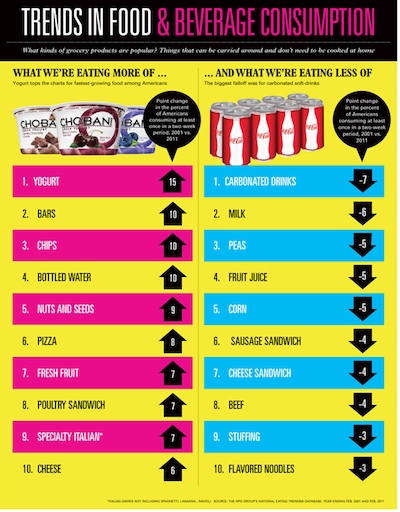Five trends affecting the way Americans eat
What Americans are eating is more complex than ever, with several consumer groups shaping the food world with rapidly diverging tastes.
In Ad Age’s report “How America Eats Today,” it listed the drive for convenience; the disappearing middle market, influence of millennials, push for simple ingredients, and the rise of specialty foods as the leading trends in food.
Brands are now putting old products in new convenient packages to meet the needs of today’s grab-and-go consumer.
Take Kellogg’s Eggo Wafflers, flavoured waffle bars that can be eaten out of the toaster with no syrup.

J&J Snack Foods Corp.’s Tater Stuffers meanwhile, puts together hashed-brown potatoes, eggs, cheese green peppers and onions into rolled form.

Another trend is middle market being pushed aside by the rise of what Ad Age calls food elites and food realists.
Food elites are those who earn more than $100,000 a year and demand natural and handmade foods.
However, Ad Age reports that food realists make up the majority of the population and seek value and brands that are familiar.
Nusara Chinnaphasaen of ad agency Cramer-Krasselt, said in the report that food is "such a mark of our social status and it really has divided people more than ever before.”
To meet the needs of the various groups, food companies are offering the same brands at different price points and in different formats.
The article pointed to Kraft Foods Group's "good, better, best" approach that puts its economy brands at dollar stores, while its Cracker Barrel cheese brand ads spotlight the awards it has won at prestigious cheese competitions.
To attract elites, companies are also paying closer attention to food-as-lifestyle scene, said Ad Age, with consumers being influenced by films, shows and restaurants leading to expectations at the grocery store.
While everyone has heard of millennials, the report said get ready for the “Yemmie”–the young educated, millennial, not so loyal mother who demands food variety.
Campbell Soup’s “Go Soup” products for this group come in microwavable pouches in exotic flavours.

While Frito-Lay also goes for ethnic-inspired flavours with its Doritos Jacked line (smoky chipotle barbecue), and Doritos Dinamita, a chile-limon chip in rolled form.
Today’s consumer also wants more simple ingredient lists.
Kellogg is promoting its Raisin Bran as being made with “seven ingredients or less,” said the article, while Yoplait’s Simplait contains “just 6 simple ingredients."

Lastly, specialty food is gaining ground over big brands. The article points to the National Association for the Specialty Food Trade latest figures that showed specialty food sales grew 9.2 per cent from 2009 to last year, reaching $75.14 billion.
The big companies are now investing more into smaller divisions to tap into this trend.
Kellogg, for instance, is looking at its Kashi natural cereal brand to be its pioneering health brand, said Kellogg North America president Brad Davidson in Ad Age.
The next big thing is expected to be "local-global" such as Chulita's Famous, a Latin seasonings company based in Brooklyn that specializes in sofritos, a mix of Latin herbs, vegetables and spices.

Here's an infographic from Ad Age on what food is trending up (and down) with U.S. consumers:

